Dream Dream Revolution: Dive Bars, Ghosts, and One Red Ribbon
Exhibitions by Mary Gibney, Jaime Black, and Shirin Neshat explore dreams as portals to the collective unconscious: what haunts us now?

Dodging ice sheets on a South Minneapolis sidewalk on my way to see art, I dared look up for a moment or two—just long enough to read these words on a storefront window: “Who looks outside, dreams; who looks inside, awakens.” Attributed to Carl Jung, the quote reverses much of the commonly held beliefs about dreamers as self-absorbed, head-in-the-clouds, possibly quite impractical people. Instead, those who focus on the external world and its many foibles are cast in the role of clueless dreamers who miss the essential part of being human: waking up to our inner lives. The dream here is delusion, a cosmic veil, keeping us from true insight—which is somewhat surprising given Jung’s life-long fascination with the study of dreams not only as clues for individual healing but as portals to the collective unconscious.
Enlightenment doctrine, famously etched into the cultural imagination by Goya, cautions that the sleep of reason births monsters. Sensations and thoughts disowned by the waking mind churn and rise and reach for us from the darkness of the subconscious. But these monsters have a lot to offer: psychoanalyst Christopher Bollas calls them the “unthought known,” a species of thought accessible only through oneiric imagery and somatic symptoms.1 Visions and prophecies germinate in this fecund darkness. Beyond the confines of individual psychic life, dreams, and the compulsion to share them, connect us in ways that do not quite make sense. Thus writes Sharon Sliwinski in her pre-pandemic book Dreaming in Dark Times. Whether we imagine this connective tissue as a mycelium-like subterraneous web, a vast collective unconscious, or an ancestral archive, or choose to follow feminist theologian Catherine Keller into the Deep (as Fred Moten suggested), or dive into Alexis Pauline Gumbs’ Black oceanic simultaneity, where one body is no longer (and never has been) an adequate unit of measure—dreams offer weird portals into space-times beyond reason, into stranger ways of knowing. Maybe, along with the rise of trauma-informed somatics and growing respect for non-western worldviews, that is why dreams have resurfaced in recent visual art as an intriguing theme.
The upsurge of interest in dreaming is no Surrealist redux, though. Instead, it is a sign of the times, of shared desires, anxieties, and fears: what was there to do while sheltering-in-place other than dream? And what haunts us now, as life resumes a mostly pre-pandemic pace? Looking at art over the past couple of months, trudging through snow and traveling to less wintry places, I was struck by the preponderance of dreams: from Mary Gibney’s quasi-hallucinatory pandemic paintings collectively titled Funhouse Waiting Room in Minneapolis to Jaime Black’s She Holds Water at The Catherine G. Murphy Gallery in St. Paul, and to Shirin Neshat’s solo exhibition Land of Dreams at SITE Santa Fe—there’s a hunger for the absurd and associative logic of dreams, not exactly escapist in tone but more invested in conjuring other ways of being in the world.2
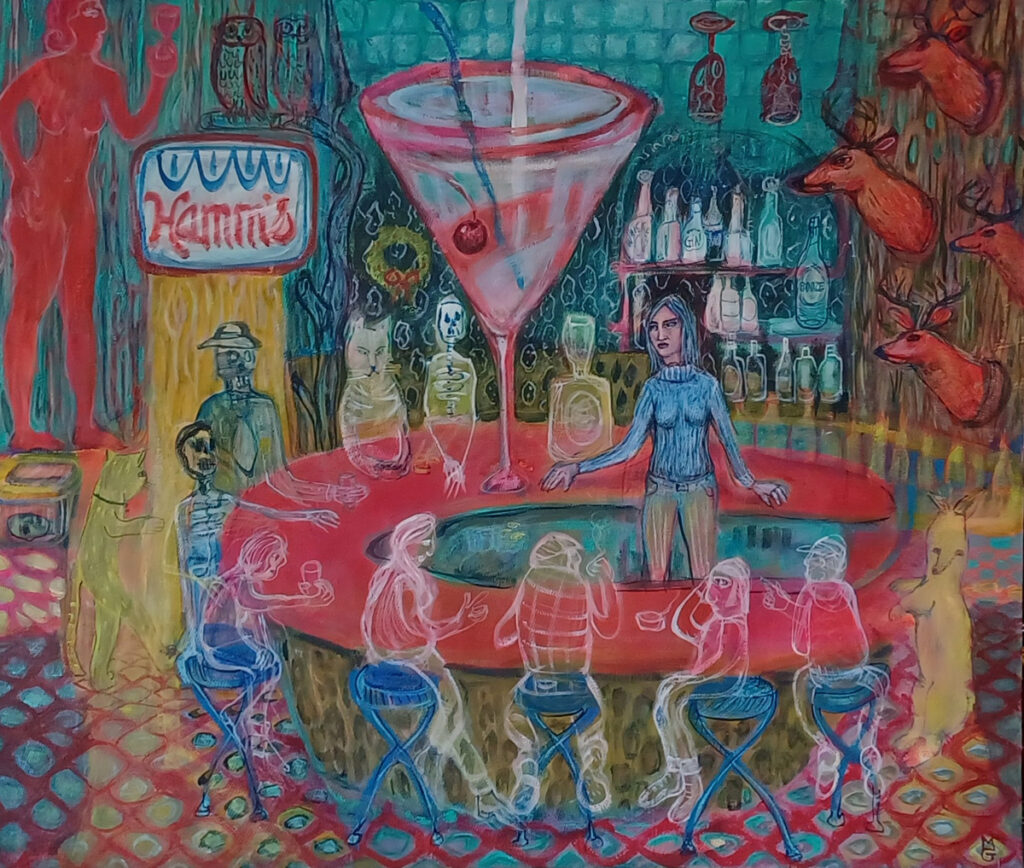
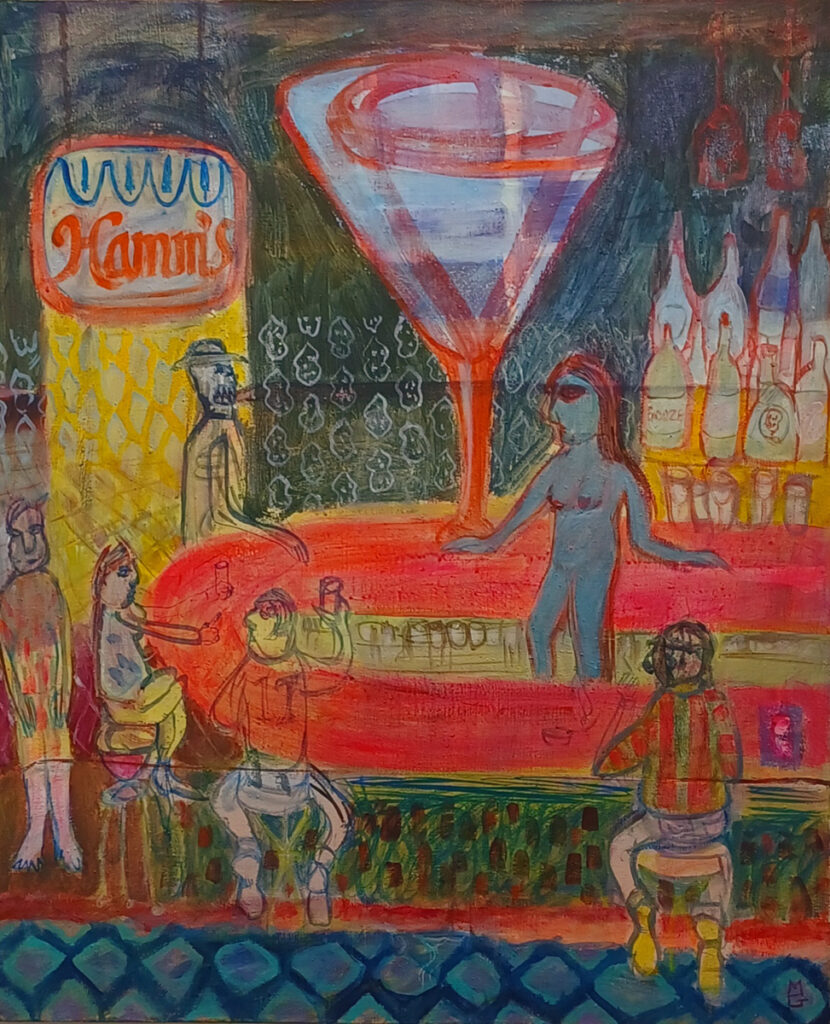
Mary Gibney’s post-pandemic paintings take us into dive bars, distorted by funhouse mirror-dream-logic into spaces both familiar and uncanny. In Bar Pool, Giant Cocktail Shaker (2022), the bartender looks like a cross between Guillermo del Toro’s humanoid amphibian from The Shape of Water and the creature from the Black Lagoon; in Bar Scene Hamm’s Sign Blue Bartender (2022) a naked and blue bartender, all aloof allure, serves a veritable menagerie of oddballs. The patrons, too, come with a surrealist edge: some are disconcertingly transparent, outlined in a few white lines. There are giant cats and three barely-there-ghosts hovering by a pool table. Paired with Rainbow Cemetery (2022)—big trees, lots of statues, and a few critters under the eponymous rainbow—the series of bar paintings conjures a strange sense of loss, longing, and moving on: the dead are hanging out with us, doing shots, lounging, and debating the finer points of pool. Far from elegiac, the work pays tribute to these strange days of returning, not to a sense of normal, but something else. Somewhere else. A haunted place, perhaps?
A desk sits in the center of the gallery, cluttered with sketchbooks, a typewriter, two vintage globes, and several View-Masters. The latter promise escapes to exotic locations, from tourist traps to legendary Hollywood dreamlands: the Tin Man carries a drugged Dorothy past blood-red poppies in one slide. The objects read as nostalgic, more so than your regular retro fad: they churn pandemic feels of isolation, entrapment, and confinement. Remember when we used to be able to travel, they ask. One of the repurposed books on the desk is dedicated to telling fortunes. The drawings are cartoon-like, and there is humor in the work and its faux oracular pronouncements: “You will take a nap.” “You will pet a dog.” “You will carry a log,” Twin-Peaks-log-lady-style. Dreams, fortunes, and strange visions keep shifting shape in Gibney’s work. Owls gather underneath the familiar crest of Minnehaha Falls, while elsewhere a sad fox communes with its reflection in a moonlit pond.
Gibney’s work is playful and fresh. What I find most compelling is the way her dreamlike bar scenes and friendly cemetery capture something—a public mood, maybe—about the cusp of post-pandemic life. To quote Sliwinksi, “oneiric events can be understood as containing information that exceeds the dimension of the singular subject.”3 We may not be able to grasp exactly how and why that happens, yet evidence of such strange excesses is hard to explain away.4 Maybe it is the zeitgeist saying hello—the German literally translates to “the ghost of the times.” And it’s going strong.
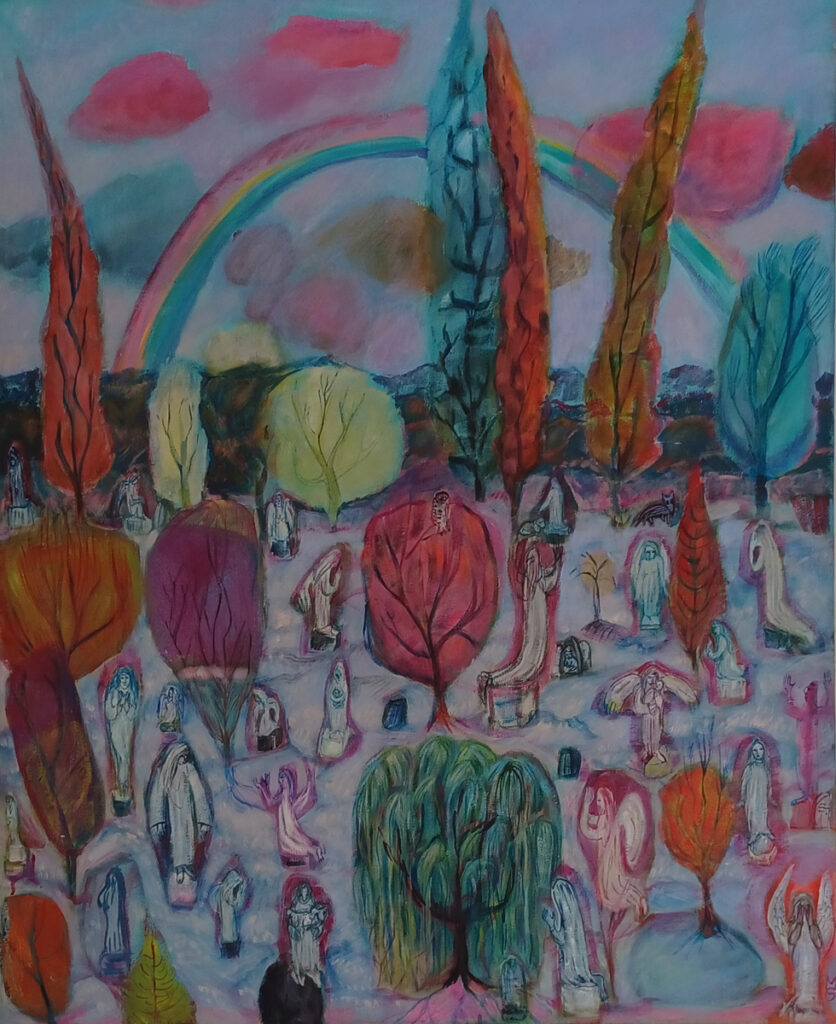
Consider recent exhibitions of note: dream visions and oneiric prophecies featured prominently in Robert Cozzolino’s Supernatural America. Long deemed too “para” and not sufficiently “normal,” the exhibition’s artworks explored the “spectral imagination and so-called anomalous experiences…central to American art and the lives of innumerable artists.”5 Like Jung decades earlier, Cozzolino acknowledges his own experiences with prophetic dreams, visions, and guiding voices. He is not alone. Across the Atlantic, writing about an exhibition titled Into the Black Fantastic, Kameelah L. Martin includes dream interpretation in her discussion of Black women’s intellectual legacies of spirit work which she dubs “conjure feminism”: a type of womanist activism that is also “ancestral work that creates genealogies of knowledge and other ways of knowing that are inherited, transmitted, and bequeathed orally among women of African descent.”6 Far from being disconnected from the outside world where racism runs rampant, this work is deeply connected to bearing culture in the African diaspora and validating ways of knowing that do not rely on reason alone. In other words, an interest in dreams need not be limited to the purely introspective. Far from it.
Jaime Black’s She Holds Water is a case in point. An immersive installation in Saint Kate’s Catherine G. Murphy gallery, the exhibition continues the artist’s unique commemorative-activist work. Black’s The REDress Project is legend and contributed significantly to raising awareness about missing and murdered Indigenous women on an international scale. She Holds Water centers healing through connecting with the land. One central video loop follows a dreamlike performance-ceremony: a woman approaches a lakeshore. Where stone meets water, she crouches to submerge a red ribbon before entering the water herself. As her body moves in the water, the red ribbon floats and eddies around her, part umbilical cord, ancestral bloodline, and one thread of red dress/re-dress in a place haunted by the legacies of colonial violence.
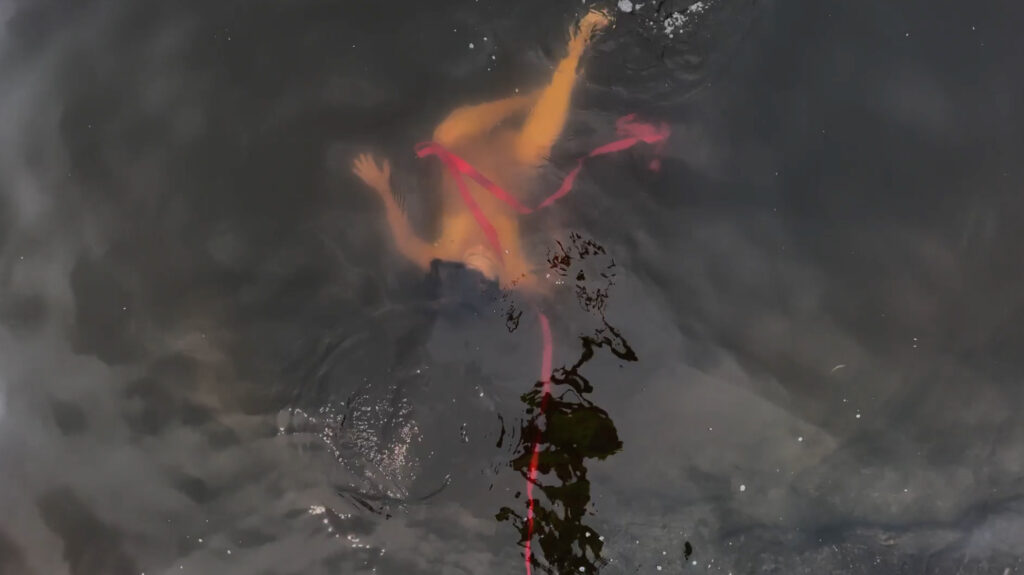
On the gallery floor, an untitled poem written by Black and printed in the shape of a meandering river, repeats one line: “We dream the revolution.” The words echo, ripple, and reverberate. Dreaming is not an escape into obscurity here. Instead, dreaming points to what is missing in the present. Even daydreaming can be charged with political purpose and resurgent vision. As the poem flows across the floor, its line breaks give way to a stream of consciousness that becomes a chant, an incantation, a spell. Visually, too, Black uses repetition. Two smaller projections flank the central screen. Here, the artist interacts with a frozen stream, leaving a circle of footsteps in the snow. She squats to thread the red ribbon through a hole in the ice, entrusting it to the unseen current below to carry it to who-knows-where. In another shot, the red ribbon lies on top of the ice, its curves a visual echo of the waterway below. Then, a mirror image: a female figure meets her double. The two stand facing each other, one hand raised, palms up, not quite touching, in a silent salute. An invisible threshold divides them. Something, someone, has been lost, irretrievably, but their ghostlike absence conjures a presence in its own right. The video does not answer the question of who is dreaming whom. Neither of the spectral figures has a claim on the real. And maybe that is part of the point.
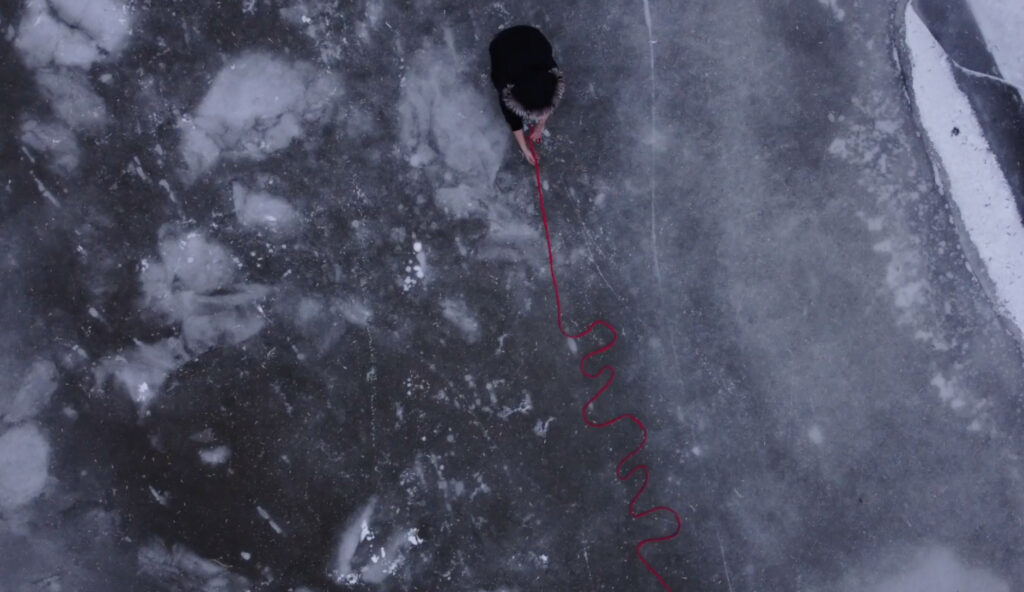
Dreams disorient the certainty of a distinct self. “Dreaming is among our most intimate encounters with the experience of being governed by an agency other than the self.”7 While waking minds are temporarily silenced, we are at the mercy of the strange imagery that finds us in dreams, experiencing what our waking minds cannot bear. Thus, writes Sliwinski, dreams offer “evidence of an indestructible alterity in each of us.”8 Dreams confront us with a kind of powerlessness, since most of us cannot steer them, and porosity: mundane experiences seep into dreams where they are reconfigured and may give rise to visions and visitations that feel larger than any individual self. Whether we dismiss or fetishize these experiences is perhaps a matter of character and proclivity. But both powerlessness and porosity land hard when put into the context of post-pandemic life. And both play central parts in Shirin Neshat’s Land of Dreams.
The exhibition centers a two-channel video installation, accompanied by black and white portraits of individuals who shared their most recent dream with the artist. These dreams are recorded and hand-written in Farsi on each photograph. The film’s narrative follows a young woman, played by Sheila Vand, who works as a “dream catcher” for an underground colony of spies. She poses as an art student to gain access to people’s homes and photographs them before asking about their dreams. Thus, the film’s plot and Neshat’s process resemble each other—up to a point. The film’s lead gets in trouble when she enters one of her subjects’ dreams. Her file is confiscated and inspected by a hierarchy of supervisors. When obliged to recount the problematic dream to a superior—unsurprisingly, in Neshat’s filmic universe, a bearded man—the waif-like “dream catcher” slips between pronouns— “she” lapses into “I” —which proves her breach of protocol. No punishment is necessary, the authorities inform her, because surely, the dream catcher will go mad, having entered someone else’s dream. Promptly expelled from “the colony,” the waif leaves.
Land of Dreams (2019) is a complex work, no doubt. Timely references include the mirage of “America” as the land of dreams that has long enthralled immigrants. The theft of super-private information staged as espionage bears uncanny resemblance to Big Data’s surveillance capitalism. But housing the dream lab’s operations inside the rock formation known in English as Shiprock—a monadnock located in the Navajo nation and known there as Tsé Bitʼaʼí, which translates to “rock with wings” or “winged rock”—raises questions of a different sort, as does the way Neshat pictures “dream catching.” Rather than protect, her dream catcher lies and spies, until one subject’s dream crosses over and engulfs her. Neshat riffs on sites and stories that hold meaning in Indigenous cultures without addressing her relationship, her claim, to them. They are folded into a visually sumptuous narrative that remains oblivious to its complicity in structures of domination. (Aruna D’Souza points out a similarly cynical moment in her review of Neshat’s The Fury.)
Land of Dreams screened alongside three short films, all shot in dramatic black and white: Roya (2016), Sarah (2016), and Illusions & Mirrors (2013). Collectively, they could be titled waif-watching, as Neshat’s iconic lead characters invariably present slender, young female bodies in distress or, at the very least, in the throes of a borderline-nightmarish experience. In each of the films, the central character encounters a form of threshold where they face a double—whether maternal, ancestral, spiritual, or past selves. Yet these thresholds and visions leave intact the distinction between the dreamer and the dream, which separates them from the moment of trespass that occurs in Land of Dreams. Writing about the films, Neshat mentions recurring dreams and the limitations of rational dream interpretations. The narratives of her films mimic the associative “logic” of dreams. And yet: this logic disappoints. While in Iran young women dare dream the revolution at the risk of rape, death, and violent disappearance, Neshat’s oneiric imaginary remains insular, lacking that which exceeds the singular subject and freighted with gender-essentialist clichés. Even though Sliwinski may well be right in observing that dreams “operate without mastery of their content” which is “not governed by reason,”9 art, once it leaves the studio and enters the world, will be held accountable for its vision. Art is not a dream; the artist never only a vessel, a dreamer whose imagination and dream life are miraculously untainted. The veil between the conscious and unconscious mind may be porous but, when transforming dreams into art, we are far from powerless.
Mary Gibney’s Funhouse Waiting Room is on view at Rosalux Gallery in Minneapolis through February 26, 2023. >> more information
Jaime Black’s She Holds Water is on view at The Catherine G. Murphy Gallery in St. Paul through March 19, 2023. >> more information
Shirin Neshat: Land of Dreams was on view at SITE Santa Fe from October 2022 through January 2023. >> more information